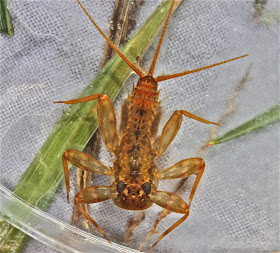Friday, February 17, 2012
More Thoughts on Stream Protocol and the "Scores" That We Use
No, I swear that's the actual color. It may be a killer -- but it sure is a beautiful stonefly. The Perlodid stonefly, Clioperla clio. If you're collecting mayflies and stoneflies and you get one of these, put it in a bowl by itself; otherwise, you'll soon find that some of your other insects are missing!
I went up the Doyles River today to a spot that I like to visit -- where Rt. 810 takes a sharp right and crosses over the stream. This is roughly 8 miles north of White Hall, VA. The leaf packs were "packed" with the little Perlodids, Isoperla nr. namata -- I saw dozens of them -- while the bottoms of rocks were literally crawling with the flatheaded mayflies, Epeorus pleuralis. The Isoperlas will hatch out in April and May as "Yellow Sallies" (in fly fishing terms), while the Epeorus mayfly emerges in March and April as the "Quill Gordon." Ought to be great trout fishing here in the spring -- if only there were some trout!
On my way back into town, I decided to look for some small minnow mayflies at a spot lower down on the Doyles, roughly 1 mile outside of White Hall. I had a theory to explore, that being that the orange/brown H. amplum nymphs are males while the olive ones are females. I sorted through some leaves and had 6-8 nymphs in 5-10 minutes. I found only one Isoperla nr. namata: at the upper site, I had found no small minnow nymphs. I also found, at the upper location, a bunch of free-living caddisfly larvae, and some Maccaffertium pudicum flatheaded nymphs, along with the Epeorus pleuralis and the I. nr. namata, all good indicators of a real healthy stream.
There's a point to make here before I get to some photos. The "score" we assign to a stream as an indication of the health of that stream all depends on the part of that stream that's being examined. The upper Doyles river is very clean water, being close to the boundary of the Shenandoah National Park. The insects here are quality insects with very low tolerance values. The lower site I explore isn't bad, but I've never seen a free-living caddis here, and I've never seen Giant stoneflies (I've seen them up above), and it's a superb location to look for small minnow mayflies (which are, relatively speaking, pretty tolerant critters). If we "score" the Doyles at the upper location it will come out as a very good stream; if we score it at the lower location -- well, it's fair to good, but the score will be quite a bit lower. How do you decide where to sample?
More photos taken today.
1. A beautiful brown/orange Strophopteryx fasciata large winter stonefly.
2. One of several Lepidostomatids in its little square case made out of leaves.
3. A flatheaded mayfly, Maccaffertium pudicum.
4. One of the many Epeorus pleuralis nymphs that I saw -- and note that the wing pads are now getting long.
5. A "group" shot of an M. pudicum nymph with a E. pleuralis nymph -- so you have a sense of the relative size. M. pudicums are BIG. This one measured 14mm.
6. A couple of the Isoperla nr. namatas.
7. One of the free-living caddisfly larvae: Rhyacophila fuscula, I think. But I need to check; there's something a bit odd with the topless "H" on the head.
8. From the lower site -- another Helopicus subvarians Perlodid stonefly. They're pretty common in here.
9. And finally, two of the six small minnow mayflies I found in the stream down by White Hall. They're Heterocloeon amplums, and yes, the males (big, red eyes) are the ones that look a orange/brown; the females (small, dark eyes) are olive.













No comments:
Post a Comment